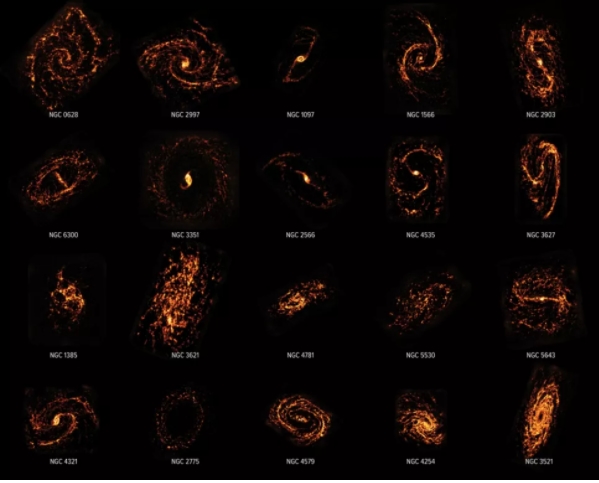100,000 star nurseries mapped in first-of-its-kind survey

Stellar nurseries, the cauldrons of gas and dust where stars are forged, are far more diverse than astronomers first thought, according to a new, first-of-its kind survey.
Astronomers at the Physics at High Angular Resolution in Nearby Galaxies (PHANGS) project have systematically charted more than 100,000 nurseries across 90 galaxies, and found that each one is far more unique than first thought.
Stars can take tens of millions of years to form — growing from billowing clouds of turbulent dust and gas into gently glowing protostars, before finally materializing into gigantic orbs of fusion-powered plasma like our sun. But how quickly this process depletes a nursery’s store of gas and dust, and how many stars are subsequently able to form in a given place, depends on a stellar nursery’s location in a galaxy.
“We used to think that all stellar nurseries across every galaxy must look more or less the same, but this survey has revealed that this is not the case, and stellar nurseries change from place to place,” lead author Adam Leroy, associate professor of astronomy at The Ohio State University, said in a statement. “These nurseries are responsible for building galaxies and making planets, and they’re just an essential part in the story of how we got here.”
NGC4535, a spiral and stellar bar galaxy, was also included in the survey.
NGC4535, a spiral and stellar bar galaxy, was also included in the survey. (Image credit: ALMA (ESO/NAOJ/NRAO)/PHANGS, S. Dagnello (NRAO))
The five-year survey, conducted across a section of the cosmos known as the nearby universe because of its proximity to our own galaxy, used the Atacama Large Millimeter/Submillimeter Array (ALMA) radio telescope located in Chile’s Atacama Desert. By conducting their survey in the radio part of the electromagnetic spectrum, rather than the optical part, the astronomers could focus on the faint glow from the dust and gas of the dark and dense molecular clouds, as opposed to the visible light from the young stars birthed by them.
This allowed the researchers to study how a star’s home cloud shapes its formation.
“To understand how stars form, we need to link the birth of a single star back to its place in the universe. It’s like linking a person to their home, neighborhood, city and region. If a galaxy represents a city, then the neighborhood is the spiral arm, the house the star-forming unit, and nearby galaxies are neighboring cities in the region,” PHANGS principal investigator Eva Schinnerer, an astronomer at the Max Planck Institute for Astronomy, said in the statement. “These observations have taught us that the ‘neighborhood’ has small but pronounced effects on where and how many stars are born.”
They found that stars are forged differently depending on whether the molecular clouds that create them are located in galactic discs, stellar bars, spiral arms or galactic centers.
A small selection of the 90 galaxies included in ALMA’s survey.
A small selection of the 90 galaxies included in ALMA’s survey. (Image credit: ALMA (ESO/NAOJ/NRAO)/PHANGS, S. Dagnello (NRAO))
“Clouds in the dense central regions of galaxies tend to be more massive, denser and more turbulent than clouds that reside in the quiet outskirts of a galaxy,” said co-author Annie Hughes, an astronomer at L’Institut de Recherche en Astrophysique et Planétologie. “The life cycle of clouds also depends on their environment. How fast a cloud forms stars and the process that ultimately destroys the cloud both seem to depend on where the cloud lives.”
Next, the team will try to figure out what this variation could mean for the formation of stars and planets, as well as for our own place in the universe.
“This is the first time we have gotten a clear view of the population of stellar nurseries across the whole nearby universe. In that sense, it’s a big step towards understanding where we come from,” Leroy said in the statement. “While we now know that stellar nurseries vary from place to place, we still do not know why or how these variations affect the stars and planets formed. These are questions that we hope to answer in the near future.”
The researchers presented their findings on Tuesday (June 8) at the online summer meeting of the American Astronomical Society, and they published their findings April 15 on the preprint server arXiv, so the study has yet to be peer-reviewed.
Originally published on Live Science.
Stellar nurseries, the cauldrons of gas and dust where stars are forged, are far more diverse than astronomers first thought, according to a new, first-of-its kind survey.
Astronomers at the Physics at High Angular Resolution in Nearby Galaxies (PHANGS) project have systematically charted more than 100,000 nurseries across 90 galaxies, and found that each one is far more unique than first thought.
Stars can take tens of millions of years to form — growing from billowing clouds of turbulent dust and gas into gently glowing protostars, before finally materializing into gigantic orbs of fusion-powered plasma like our sun. But how quickly this process depletes a nursery’s store of gas and dust, and how many stars are subsequently able to form in a given place, depends on a stellar nursery’s location in a galaxy.
Related: The 12 strangest objects in the universe
“We used to think that all stellar nurseries across every galaxy must look more or less the same, but this survey has revealed that this is not the case, and stellar nurseries change from place to place,” lead author Adam Leroy, associate professor of astronomy at The Ohio State University, said in a statement. “These nurseries are responsible for building galaxies and making planets, and they’re just an essential part in the story of how we got here.”
NGC4535, a spiral and stellar bar galaxy, was also included in the survey.
The five-year survey, conducted across a section of the cosmos known as the nearby universe because of its proximity to our own galaxy, used the Atacama Large Millimeter/Submillimeter Array (ALMA) radio telescope located in Chile’s Atacama Desert. By conducting their survey in the radio part of the electromagnetic spectrum, rather than the optical part, the astronomers could focus on the faint glow from the dust and gas of the dark and dense molecular clouds, as opposed to the visible light from the young stars birthed by them.
This allowed the researchers to study how a star’s home cloud shapes its formation.
“To understand how stars form, we need to link the birth of a single star back to its place in the universe. It’s like linking a person to their home, neighborhood, city and region. If a galaxy represents a city, then the neighborhood is the spiral arm, the house the star-forming unit, and nearby galaxies are neighboring cities in the region,” PHANGS principal investigator Eva Schinnerer, an astronomer at the Max Planck Institute for Astronomy, said in the statement. “These observations have taught us that the ‘neighborhood’ has small but pronounced effects on where and how many stars are born.”
They found that stars are forged differently depending on whether the molecular clouds that create them are located in galactic discs, stellar bars, spiral arms or galactic centers.
A small selection of the 90 galaxies included in ALMA’s survey.
A small selection of the 90 galaxies included in ALMA’s survey. (Image credit: ALMA (ESO/NAOJ/NRAO)/PHANGS, S. Dagnello (NRAO))
“Clouds in the dense central regions of galaxies tend to be more massive, denser and more turbulent than clouds that reside in the quiet outskirts of a galaxy,” said co-author Annie Hughes, an astronomer at L’Institut de Recherche en Astrophysique et Planétologie. “The life cycle of clouds also depends on their environment. How fast a cloud forms stars and the process that ultimately destroys the cloud both seem to depend on where the cloud lives.”
Next, the team will try to figure out what this variation could mean for the formation of stars and planets, as well as for our own place in the universe.
“This is the first time we have gotten a clear view of the population of stellar nurseries across the whole nearby universe. In that sense, it’s a big step towards understanding where we come from,” Leroy said in the statement. “While we now know that stellar nurseries vary from place to place, we still do not know why or how these variations affect the stars and planets formed. These are questions that we hope to answer in the near future.”
The researchers presented their findings on Tuesday (June 8) at the online summer meeting of the American Astronomical Society, and they published their findings April 15 on the preprint server arXiv, so the study has yet to be peer-reviewed.



 Creators of mankind
Creators of mankind Description of “Tall white aliens”
Description of “Tall white aliens” Where they came from?
Where they came from? About hostile civilizations
About hostile civilizations The war for the Earth
The war for the Earth “Tall white aliens” about eternal life
“Tall white aliens” about eternal life Video: “Nordic aliens”
Video: “Nordic aliens” Aliens
Aliens Alien encounters
Alien encounters The aliens base
The aliens base UFO
UFO Technology UFO
Technology UFO Underground civilization
Underground civilization Ancient alien artifacts
Ancient alien artifacts Military and UFO
Military and UFO Mysteries and hypotheses
Mysteries and hypotheses Scientific facts
Scientific facts


















